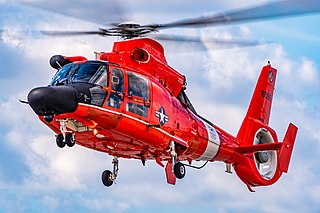
The Eurocopter MH-65 Dolphin is a twin-engined helicopter operated by the United States Coast Guard (USCG) for medevac-capable search and rescue (SAR) and armed Airborne Use of Force missions. It is a variant of the French-built Eurocopter AS365 Dauphin.

The Grumman HU-16 Albatross is a large, twin–radial engined amphibious seaplane that was used by the United States Air Force (USAF), the U.S. Navy (USN), the U.S. Coast Guard (USCG), and the Royal Canadian Airforce RCAF primarily as a search and rescue (SAR) aircraft. Originally designated as the SA-16 for the USAF and the JR2F-1 and UF-1 for the USN and USCG, it was redesignated as the HU-16 in 1962. A new build G-111T Albatross with modern avionics and engines was proposed in 2021 with production in Australia to commence in 2025.

Coast Guard One is the call sign of any United States Coast Guard aircraft carrying the president of the United States. Similarly, any Coast Guard aircraft carrying the vice president is designated Coast Guard Two.

Coast Guard Air Station Kodiak is an Air Station of the United States Coast Guard located in Kodiak, Alaska. It is the largest in the service's Pacific Area, with a crew of 85 officers and 517 enlisted personnel, and the largest Coast Guard Base in terms of physical size at 23,000 acres. It is a tenant command of Base Support Unit Kodiak, and shares its airfield with Kodiak Airport. The station operates MH-60 Jayhawk and MH-65 Dolphin helicopters, and the HC-130 Hercules fixed-wing aircraft.

United States Coast Guard Air Station Clearwater is the United States Coast Guard's largest air station. It is located at the St. Petersburg-Clearwater International Airport in Clearwater, Florida and is home to nearly 700 USCG aviation and support personnel. As of March 2021, there are ten MH-60T Jayhawk helicopters and four HC-130H Hercules aircraft assigned to CGAS Clearwater. Also on static display is USCG 1023, a restored Grumman HU-16 Albatross.

The Sikorsky MH-60T Jayhawk is a multi-mission, twin-engine, medium-range helicopter operated by the United States Coast Guard for search and rescue, law enforcement, military readiness and marine environmental protection missions. It was originally designated HH-60J before being upgraded and redesignated beginning in 2007.

The Sikorsky HH-52 Seaguard was an early amphibious helicopter designed and produced by American helicopter manufacturer Sikorsky Aircraft. It was the first of the company's amphibious rotorcraft to fly.

The Guardian is a 2006 American action-adventure drama film directed by Andrew Davis. The film stars Kevin Costner and Ashton Kutcher. The title of the film refers to a legendary figure within the film which protects people lost at sea: "the Guardian". The film focuses on the United States Coast Guard and their Aviation Survival Technician program. The Guardian was released on September 29, 2006.

Coast Guard Air Station Elizabeth City is a United States Coast Guard Air Station co-located at Elizabeth City Regional Airport in Elizabeth City, North Carolina, along the Pasquotank River near the opening of the Albemarle Sound. The base has a garrison of approximately 855 officers and enlisted. The Coast Guard air station is also one of the busiest in the U.S. Coast Guard, operating missions as far away as Greenland, the Azores and the Caribbean.
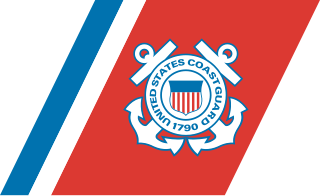
A Coast Guard Air Station provides aviation support for the United States Coast Guard. The Coast Guard operates approximately 210 aircraft from 24 Coast Guard Air Stations in the United States. Fixed-wing aircraft, such as the HC-130 Hercules, are built for long range missions and operate from air stations. The MH-65D Dolphin and Sikorsky HH-60 Jayhawk helicopters also operate from Air Stations, Air Facilities and flight deck equipped cutters.
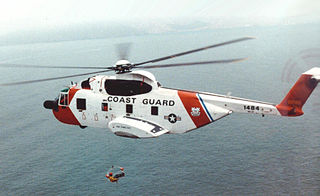
The Sikorsky S-61R is a twin-engine helicopter used in transport or search and rescue roles. A developed version of the S-61/SH-3 Sea King, the S-61R was also built under license by Agusta as the AS-61R. The S-61R served in the United States Air Force as the CH-3C/E Sea King and the HH-3E Jolly Green Giant, and with the United States Coast Guard as the HH-3F, nicknamed "Pelican".
Outstanding Aircrew Member's Award . This award was established in 1963 by the parents and friends of the late Lieutenant Perchard, who died in company with his fellow crewmembers while serving as co-pilot aboard an HU-16E on a rescue mission in Alaska. Through this award, each aviation unit is able to recognize an assigned enlisted aircrew member as having demonstrated exemplary performance and superior technical, aviation, professional, and leadership abilities. The selection of personnel to be honored with the Outstanding Aircrew Member's award is made on a semiannual basis using criteria in keeping with the intent of the award.
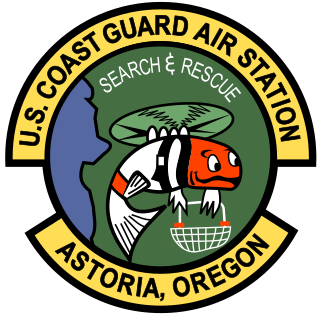
Coast Guard Air Station Astoria was established on August 14, 1964, at Astoria Regional Airport in Warrenton, Oregon, United States.

Coast Guard Air Station Salem was a United States Coast Guard air station located in Salem, Massachusetts from 1935 to 1970. Its area of coverage extended from New York City to the Canada–United States border.

Coast Guard Air Station Traverse City was established in 1946 and operates under the authority of the United States Coast Guard's Ninth District (USCG). It is situated on the southern end of Grand Traverse Bay in Northern Michigan at Cherry Capital Airport in Traverse City, Michigan, United States. Since 1995, Air Station Traverse City has controlled and staffed Air Facilities throughout southern Lake Michigan. The area of operations includes all of Lake Michigan and Lake Superior and most of Lake Huron.

Coast Guard Air Station Borinquen is a United States Coast Guard Air Station located at the Rafael Hernandez International Airport, in Aguadilla, Puerto Rico.

Coast Guard Air Station San Francisco is a United States Coast Guard Air Station located 13 miles (21 km) south of downtown San Francisco, California, at the San Francisco International Airport in an unincorporated area of San Mateo County. The air station sits adjacent to the airport which consists of its own ramp, one hangar, an administration building and several other support structures.

United States Coast Guard Air Station Houston is a United States Coast Guard Air Station located 15 miles (24 km) southeast of downtown Houston, Texas on board the Ellington Field Joint Reserve Base (JRB).

Coast Guard Air Station Sitka, Commanded by Commander Vincent J. Jansen, is an Air Station of the United States Coast Guard located in Sitka, Alaska. The station was originally established on Annette Island in March 1944, until relocating to Sitka in 1977. Early aircraft consisted of Grumman G-21's, PBY’s, HU-16’s, HH-52’s, and HH-3 Pelicans. Primary missions performed by the air station are Search and Rescue (SAR), law enforcement, and logistics covering the Southeast part of Alaska. Area of responsibility encompasses approximately 180,000 square miles of water and land extending across Southeast Alaska from Dixon Entrance to Icy Bay (Alaska), and from the Alaskan-Canadian border to the central Gulf of Alaska. This includes 12,000 miles of coastline distinguished by a rugged coast, mountainous terrain, severe weather, and many remote villages.
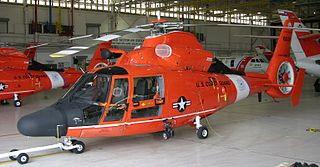
Coast Guard Air Station Corpus Christi is an Air Station of the United States Coast Guard located in Corpus Christi, Texas. The Station is co-located with Sector Corpus Christi offices at Corpus Christi International Airport. The Coast Guard Air Detachment was established on 20 November 1950, and served the entire western Gulf of Mexico with one PBY-5 Catalina fixed wing aircraft, and four pilots. In 1965, the detachment was formally designated USCG Air Station Corpus Christi. Early aircraft consisted of HU-16E Albatross, HH-52A Seaguard helicopter, HC-131 Samaritan, and HU-25A fanjet's. Following extensive personnel and equipment changes in the operations department, the air station became fully operational on October 15, 1980, and operated as one of thirteen Coast Guard Group units between Port O'Connor, Texas and the Mexican border. The Station, maintained a 24-hour Search and rescue capability, with the use of three HH-52A helicopters and three HU-25A fanjets. The Unit averaged over 400 rescues a year, which included searches for overdue vessels, assisting sinking or disabled boats, and medical evacuations from offshore oil rigs. In the spring of 1986 the station's HH-52s were replaced with the Aérospatiale HH-65 Dolphin helicopter. In May 2005 the Coast Guard commissioned Air station Corpus Christi to combine all the units within the area of Port Lavaca to Brownsville under one unified command.




























